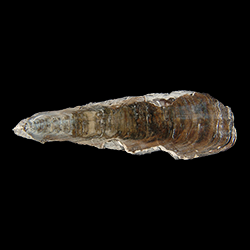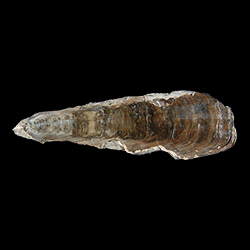
Brachiopoda

- Phylum: Brachiopoda
Overview
Brachiopods are sessile, filter-feeding animals, meaning that they live their lives anchored to the seafloor and extract the food that they require from the surrounding water. Like bivalves (e.g., clams), they have a shell composed of two halves, or valves. Bivalves have valves that are mirror images of each other, just like your two hands. This is not the case in brachiopods. Instead, brachiopods have a line of symmetry that runs across the top of the shell that makes the left side the mirror image of the right. The “heyday” of the brachiopods was during the Paleozoic era, when they were much more abundant and diverse (more species) than they were subsequently. Brachiopod fossils are only very rarely found in the Neogene fossil record of the southeastern United States. Visit the Ordovician and Pennsylvanian digital atlases to see far more examples of fossil brachiopods.
